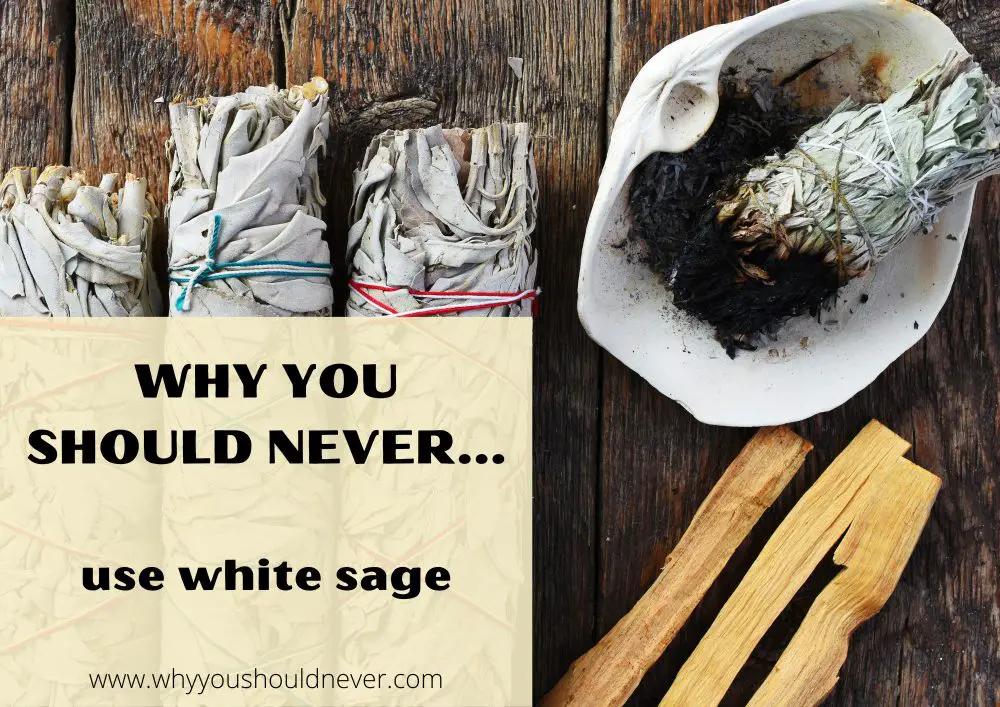![]()
Why You Should Never Use White Sage
As human beings, we’re always trying to find ways to connect with the world around us. Whether it’s through meditation, prayer or other spiritual practices, there seems to be an innate desire within each of us to tap into something greater than ourselves. One common way people try to achieve this connection is by burning white sage.
What is white sage and why is it used?
White sage (scientific name: salvia apiana) is a plant native to many parts of the Americas, including California where it has been traditionally used by Indigenous communities for medicinal and spiritual purposes. It’s often burned in bundles or smudge sticks as part of various rituals such as purification ceremonies or personal meditation practices.
Sounds pretty innocuous, right?
Well, hold on just a minute. Before you rush to pick up a bundle of white sage next time you’re at the store, here are some reasons why you might want to think twice about using it.
7 reasons why you shouldn’t use white sage
1. Cultural appropriation
Wherever you stand on the issue of cultural appropriation, it can’t be denied that the use of white sage by non-Indigenous people can be seen as cultural appropriation.
Indigenous communities have been using white sage for centuries for spiritual purposes and its commercialization and appropriation by non-Indigenous people is, in essence, a form of erasure and exploitation.
2. Environmental impact
And as with all commercialization, sooner or later, there’s bound to be some over-harvesting. White sage, unfortunately, isn’t immune to this issue. In fact, the constant demand for white sage smudge sticks has led to a decline in its populations and ecosystems where it grows.
3. No real quality control
You can buy white sage from practically anyone these days, which means that there’s no guarantee of its quality or origin. For all you know, the white sage you’re burning could be fake or even contaminated with harmful chemicals.
4. It’s expensive
Don’t think that just because white sage grows naturally in the wild that it’ll be cheap, because that couldn’t be further from the truth. A bundle of white sage can cost upwards of $15, which is a considerable amount for what’s essentially a bunch of dried leaves!
5. It’s a fire hazard
I’m speaking from experience here, so take it from me when I say that burning bundles of dried leaves can be a fire hazard. Not only do you have to be careful with the way you handle and light them, but unattended smudge sticks can easily fall over or catch onto something nearby.
Many sage packs come with a shell on which to burn the sage. This shell tends to get very hot, however, and can literally burn and melt whatever surface it’s placed on, resulting in a dangerous fire hazard.
6. It probably does nothing
Despite the claims of its proponents, there’s actually little scientific evidence to support the idea that burning white sage can cleanse or purify a space. We buy into these claims because they sound mystical and appealing, but the reality is that there’s likely nothing special about the stuff. Call it a placebo, if you will.
7. Potential to cause breathing problems
Burning white sage can have negative effects on people with respiratory problems like asthma. The smoke produced by burning dried leaves of the plant could trigger coughing, shortness of breath and irritation in individuals who are sensitive to it.
Alternatives to using white sage
Now, while burning a bit of white sage every now and then never hurt anyone (except me that one time when I nearly burned down my apartment!), it simply isn’t practical for many people. So let’s look at some alternatives.
Palo santo
Palo santo, also known as “holy wood,” has been used in traditional medicine and spiritual practices by Indigenous communities for centuries. It’s believed to have similar effects as white sage but is considered more sustainable.
Cedar
Cedar is another popular alternative that can be burned or rubbed on the body during ceremonies meant to purify a space or person of negative energies.
Sweetgrass
Sweetgrass has long been revered among many tribes for its ability to bring positive energy into spaces that promote healing and harmony – making it ideal when seeking comfort from stressful situations or creating a calming atmosphere.
Frankincense and myrrh
Frankincense is known for its relaxing properties, while myrrh can bring about feelings of tranquility and clarity. Using these resins in incense form has been a practice since ancient times among many cultures.
Lavender
Lavender has natural antidepressant qualities that make it excellent for use during meditation or prayer sessions. It’s a scent that brings peace in times of anxiety, stress or depression.
Taking a walk in nature
Connecting with nature can be a powerful way to tap into something greater than ourselves. Simply walking in the woods, sitting by the ocean or even just feeling sunlight on your skin can make all the difference to your mood and day.
